|
Find Your Edge...If you're still looking for an edge in
the markets, automated trading systems are the best way to get it.
Learn more.
|
Building Trading Systems Using Automatic Code Generation
by
Michael R. Bryant, Ph.D.
Copyright (c) 2010 Adaptrade Software. All
rights reserved.
Contents
-
Disclaimer
-
Introduction
-
The Basic Approach
-
Theoretical Basis of
Automatic Code Generation
-
Pattern System Code
Generator for TradeStation
-
Genetic Programming for
Automatic Code Generation
-
A Build Algorithm Using
Genetic Programming
-
Over-fitting
Disclaimer
HYPOTHETICAL OR SIMULATED PERFORMANCE RESULTS HAVE CERTAIN INHERENT LIMITATIONS.
UNLIKE AN ACTUAL PERFORMANCE RECORD, SIMULATED RESULTS DO NOT REPRESENT ACTUAL
TRADING. ALSO, SINCE THE TRADES HAVE NOT ACTUALLY BEEN EXECUTED, THE RESULTS MAY
HAVE UNDER- OR OVER-COMPENSATED FOR THE IMPACT, IF ANY, OF CERTAIN MARKET
FACTORS, SUCH AS LACK OF LIQUIDITY. SIMULATED TRADING PROGRAMS IN GENERAL ARE
ALSO SUBJECT TO THE FACT THAT THEY ARE DESIGNED WITH THE BENEFIT OF HINDSIGHT.
NO REPRESENTATION IS BEING MADE THAT ANY ACCOUNT WILL OR IS LIKELY TO ACHIEVE
PROFITS OR LOSSES SIMILAR TO THOSE SHOWN.
EasyLanguage and TradeStation are registered trademarks of TradeStation
Technologies, Inc.
Introduction
One of the biggest trends in retail trading over the past decade has been the
increase in the popularity of automated trading. In this type of trading, also
known as automated order execution, buy and sell signals generated by a trading
system are automatically executed by a platform connected to the trader’s
brokerage account. This allows for hands-free trading, which enables faster
execution, fewer errors, and the ability to trade shorter time frames with
higher-frequency strategies.
As more and more traders have moved to automated trading, the interest in
systematic trading strategies has increased. While some traders develop their
own trading strategies, many traders lack the programming skills necessary to
implement their ideas. Other traders lack the specific knowledge of technical
trading methods or the experience required to design a viable strategy. Even for
traders with the necessary skills for developing trading systems, the
considerable time and effort required to develop a good strategy is often a
deterrent.
A recently developed solution to this problem is the use of computer algorithms
to automatically generate trading system code. The goal of this approach is to
automate many of the steps in the traditional process of developing trading
systems. In the traditional, manual approach to strategy development, the trader
selects elements of the trading strategy based on prior experience and knowledge
of technical indicators, entry and exit order types, and strategy design.
Commonly, a strategy is based on a market hypothesis; that is, an idea of how
the market works. A viable trading strategy is typically developed through a
long trial-and-error process involving numerous iterations, revisions, and
testing until acceptable results are achieved.
This traditional process of developing trading systems is extremely time
consuming and involves systematically eliminating many ideas that simply don’t
work. Also, all traders have biases about how the markets work, and these biases
can influence the system development process. In some cases, these biases may be
helpful, but they can also limit the possible systems the trader might consider.
Rather than starting with a biased view and a limited set of rules, an automatic
code generator starts with a large set of rules and searches in an unbiased
manner for the combinations that work while quickly eliminating those that
don’t.
This paper presents an overview of automatic code generation methods for
building trading systems. Both simple and complex methods are discussed. A
simple ad hoc method is presented that can be implemented in TradeStation’s
EasyLanguage scripting language to find basic price pattern-based strategies. A
more complex approach based on genetic programming is also discussed.
Automatically generating trading systems is an attractive idea. However, there
are several drawbacks as well. For one thing, rigorous approaches, such as those
based on genetic programming, are complex and difficult to implement. Also,
automatic code generation generally relies on historical simulation, which means
it’s an optimization process. As such, the risk of over-fitting must be
addressed. These caveats are also discussed.
The Basic Approach
The basic algorithm for building trading systems using automatic code generation
is depicted below in Fig. 1. It starts with a method for combining different
elements of the trading strategy. These elements may include various technical
indicators, such as moving averages, stochastics, and so on; different types of
entry and exit orders; and logical conditions for entering and exiting the
market.
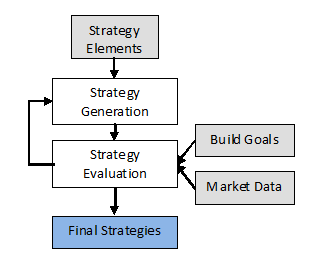
Figure 1. Basic algorithm for automated
strategy building.
After the different elements are combined into a coherent
strategy, it can be evaluated on the market or markets of interest. This
requires market data – prices, volume, open interest, etc. – for each market.
Generally speaking, you would also have a set of build goals to help rank or
score each strategy. Examples of build goals include various performance
measures, such as the net profit, drawdown, percentage of winners, profit
factor, and so on. These could be stated as minimum requirements, such as a
profit factor of at least 2.0, or as objectives to maximize, such as maximizing
the net profit.
The strategy generation and evaluation steps are repeated until the termination
criteria are met. The termination criteria could be as simple as creating a
predetermined number of different strategies, or the process might be stopped
after no further improvement in the build goals is achieved. Typically, an
optimization algorithm is used to guide the strategies towards ones that meet
the build goals. The final strategies are the ones with the highest rank or
score based on the build goals. You could either take the single best strategy
or save some number (or all) of the strategies, ranked by build goals. If there
are multiple build goals, a weighted average can be used to form a single
metric.
This is the most basic view of automatic system building. A more detailed
description will be provided below in the section on genetic programming. This
description also ignores the important problem of over-fitting, in which the
strategy is fit so closely to the market data that’s used during the build
process that the strategy doesn’t perform well in the future when applied to new
data. This issue is also addressed below.
Theoretical Basis of
Automatic Code Generation
As described above, building a trading system using automatic code generation is
essentially an optimization problem. The combination of strategy elements that
maximizes the build goals is taken as the final strategy. Some traders would
object that trading systems should be constructed based on a hypothesis of
market behavior or action. If you have a good hypothesis for how the markets
work, a strategy can be built around that hypothesis and tested. If it works, it
supports the hypothesis and justifies trading the strategy.
In fact, the approach described here is not fundamentally different than that.
Each candidate strategy constructed during the build process, as depicted in
Fig. 1, is essentially a hypothesis that is either supported or refuted by the
evaluation. If out-of-sample testing is used, the final strategies can be
further supported or refuted by the out-of-sample results.
Another way to view automatic code generation is as a problem of statistical
inference. The price data can be thought of as a combination of “signal” and
“noise”. The signal is the tradable part of the data, and the noise is
everything else. In this context, the strategy building process is a nonlinear
curve-fitting problem where the objective is finding strategies that fit the
signal while ignoring the noise and avoiding over-fitting. At the same time,
market data is often non-stationary: the statistical properties change over
time. A successful strategy is therefore one that fits the stationary elements
of the market signal with adequate degrees-of-freedom to avoid over-fitting.
Although discussed in more detail below, out-of-sample testing is generally used
to verify that the strategies are not over-fit to the market.
Pattern System Code
Generator for TradeStation
This section describes an ad hoc approach to automatic code generation in which
a trading system for TradeStation automatically generates other, pattern-based
trading systems for TradeStation. The AutoSystemGen system searches for a set of
trading rules, along with the associated parameter values, that meet a specified
set of performance requirements.
Depending on the performance requirements, it might find several or even dozens
of trading systems that meet the requirements. It then writes the EasyLanguage
code for each system to a file. For illustrative purposes, the rules for the
generated systems are restricted to price patterns. In principle, this technique
could be expanded to automatically generate systems drawing from a wide variety
of entry and exit techniques applicable to almost any market.
Price Pattern Rules
While almost any type of indicator or trading logic could be included in the
trading system generator described here, to keep things fairly simple, the rules
of the generated systems will be restricted to price patterns. Each entry rule
of a generated trading system will have the following form:
P1[N1] Ineq P2[N2]
where P1 and P2 are prices (open, high, low, or close), N1 and N2 are the number
of bars to look back (e.g., Close[2] is the close two bars ago), and Ineq is an
inequality operator, either <= or >=. Examples of rules include the following:
Close <= Close[2]
Low[2] <= High[10]
High[3] >= Close[4]
and so on. P1, P2, N1, N2, and Ineq are all variables to be determined by the
system generation process.
N1 and N2 will be restricted to the range 0 – 20. Also, the number of rules,
NRules, will be a variable with values ranging from one to 10. A trade entry
will be triggered if all the rules are true. In that case, the entry will be
taken at the open of the next bar. The trade direction will be set beforehand,
so that the system will be generating systems that are either all long or all
short trades. To obtain trading logic for both long and short trades, the system
can be run twice, once for long trades and the second time for short trades.
Trades will be exited at the market after a fixed number of bars, NX, which will
range from one to 20.
Finding the Rules
The key to this process is finding candidate trading systems. A system can
consist of between one and 10 rules of the form shown above. Trades are entered
at market if all the rules are true, and trades are exited a certain number of
bars later. If this were coded as a traditional TradeStation system, with a
maximum of 10 rules, there would be 52 inputs. This would make for a cumbersome
strategy.
Instead, a different approach will be used. At each step of the optimization,
the values for each variable (P1, P2, N1, N2, Ineq, NRules, and NX) will be
chosen randomly. A different set of values of P1, P2, N1, N2, and Ineq will be
selected for each rule, for a total of NRules sets of values.
Each step of the optimization will generate a different trading system as the
variables are randomly selected. If the performance results of the system meet
the requirements entered by the user, the generated system will be written to a
file in EasyLanguage code.
Putting it All Together
The code for the AutoSystemGen system and its related functions is available at
Breakout Futures (http://www.breakoutfutures.com/)
on the Free Downloads
page.
The first input to the strategy is called OptStep. To run the system, OptStep
should be optimized in TradeStation by varying it from 1 to some large number,
such as 10,000, in steps of 1. This will cause AutoSystemGen to generate, for
example, 10,000 different trading systems. The ones that meet the specified
performance criteria are written to the file shown as an input to the
WriteSystem function (e.g., C:\AutoSysGen-Output1.txt). The performance criteria
are specified via the system inputs (reqNetProfit, reqMaxDD, etc.).
Most of the hard work is performed by the functions that the system calls. The
function GetPatVars randomly selects the values for the variables that determine
the trading rules. To determine whether or not a trade entry will occur on the
next bar, the price pattern rules are evaluated by the function EvalPattern.
Finally, if the system meets the performance criteria, the corresponding
EasyLanguage code is generated and written out to a text file by the function
WriteSystem.
Example
As an example, consider the 30-year treasury bond futures market (symbol @US.P
in TradeStation 8). AutoSystemGen was optimized over the past 20 years of T-bond
prices with the OptStep input incremented from 1 to 10000. This means the system
evaluated 10,000 different trading systems. The optimization was run twice, once
for long trades and once for short trades. The following performance
requirements were used: net profit of at least $30,000, worst-case drawdown no
more than $7500, at least 200 trades, percent profitable of at least 50%, and
profit factor of at least 1.2. On a dual core computer running Vista, it took
approximately 10 minutes to run each optimization (10,000 systems per
optimization).
The systems generated by this process are shown below. These are the systems
written to the file AutoSysGen-Output1.txt by the WriteSystem function. The
first ones are the long-only systems, followed by a short-only system (the only
one that met the performance criteria).
System 2332, @US.P,
9/17/2007 12:23:00, Long Trades
Net Profit =
53562.50, Max DD = -7381.25, Num Trades = 250, Percent Wins = 56.80, Prof factor
= 1.631
{ System code
starts here... }
Var: EntNext
(false);
EntNext =
Open[2] >= Low[16] and
Low[9] >=
Low[3] and
Close[14]
<= Low[6] and
High[1] >=
Low[3];
If EntNext
then
Buy next
bar at market;
If
BarsSinceEntry = 2 then
Sell next
bar at market;
{ End system
code }
System 5771, @US.P,
9/17/2007 12:27:00, Long Trades
Net Profit =
42145.00, Max DD = -5733.75, Num Trades = 207, Percent Wins = 57.00, Prof factor
= 1.631
{ System code
starts here... }
Var: EntNext
(false);
EntNext =
High[7] >= Low[19] and
Close[20]
>= Close[5] and
High[18]
>= Low[2] and
High[2] <=
Open[6];
If EntNext
then
Buy next
bar at market;
If
BarsSinceEntry = 2 then
Sell next
bar at market;
{ End system
code }
System 7622, @US.P,
9/17/2007 12:29:00, Long Trades
Net Profit =
59348.75, Max DD = -7222.50, Num Trades = 208, Percent Wins = 60.58, Prof factor
= 1.924
{ System code
starts here... }
Var: EntNext
(false);
EntNext =
Low[2] <= High[9] and
Open[11]
>= Open[18] and
Close[17]
<= Low[18];
If EntNext
then
Buy next
bar at market;
If
BarsSinceEntry = 3 then
Sell next
bar at market;
{ End system
code }
System 7718, @US.P,
9/17/2007 12:29:00, Long Trades
Net Profit =
35526.25, Max DD = -6936.25, Num Trades = 292, Percent Wins = 56.85, Prof factor
= 1.418
{ System code
starts here... }
Var: EntNext
(false);
EntNext =
Close[3] >= High[19] and
High[8] >=
Low[9] and
High[6] <=
Open[10] and
Low[16] <=
High[3];
If EntNext
then
Buy next
bar at market;
If
BarsSinceEntry = 1 then
Sell next
bar at market;
{ End system
code }
System 6160, @US.P,
9/17/2007 12:42:00, Short Trades
Net Profit =
31277.50, Max DD = -6846.25, Num Trades = 369, Percent Wins = 51.76, Prof factor
= 1.297
{ System code
starts here... }
Var: EntNext
(false);
EntNext =
High[9] >= Low[6] and
Close[15]
>= High[8] and
High[7] <=
Low[20] and
High[6] >=
High[7];
If EntNext
then
Sell short
next bar at market;
If
BarsSinceEntry = 1 then
Buy to
cover next bar at market;
{ End system
code }
The listing for each system includes the system number (corresponding to the
OptStep input), market symbol, current date, and whether the system is long-only
or short-only. The next line contains a few summary performance statistics to
help in evaluating each system. Finally, the system code is shown. To evaluate
the systems in TradeStation, the code between the two comment lines ({ …}) can
be copied and pasted into a strategy in TradeStation, then run in the chart
window.
For example, the first system shown above (#2332) was copied to TradeStation and
saved as a strategy. When inserted into the @US.P chart, the following equity
curve was obtained:
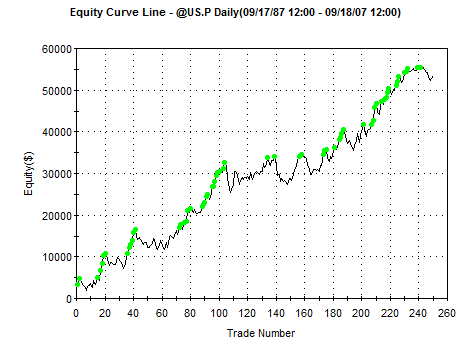
Figure 2. Long-only system for T-bonds, last 20 years, with
$15 per trade deducted for trading costs, generated by system AutoSystemGen.
The last system in the output file is for a short-only system (#6160). When
saved in TradeStation as a strategy and applied to the same T-bond chart, the
following equity curve was produced:
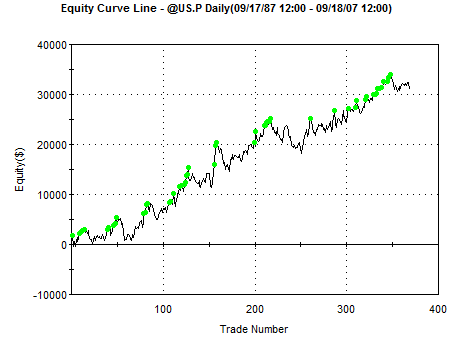
Figure 3. Short-only system for T-bonds, last 20 years, with
$15 per trade deducted for trading costs, generated by system AutoSystemGen.
With a small amount of additional effort, the two systems could be combined into
a single system that generates both long and short trades in the same system.
It’s notable that the random selection of strategy elements is as effective as
it is. There’s no optimization per se in this approach. Each strategy is
generated randomly and independently of all others. By contrast, if an
optimization method were used, the results from one step in the strategy
generation process would be used to guide the next step, and the results would
generally converge towards the build goals over successive steps. Even lacking
this, the random generation process is still fairly effective.
Even though an optimization algorithm is not used to generate the strategies,
there’s still a risk of over-fitting. Because the final strategies are selected
from a large number of candidate strategies (10,000 in this example), it’s
possible that the results could be due to random chance. To test for this, the
final strategies should be evaluated on data not used during the strategy
generation. This is called out-of-sample testing. If the out-of-sample results
are not good, the strategy is suspect.
Genetic Programming for
Automatic Code Generation
The ad hoc approach described in the previous section is simple but has two
limitations: (1) the randomly generated strategies don’t converge towards the
build goals, and (2) the template of the pattern system is difficult to
generalize to more complex strategies. This suggests a more sophisticated
approach is needed.
A method for automatic code generation that addresses both these concerns is
called genetic programming (GP),1 which belongs to a class of techniques called
evolutionary algorithms. Evolutionary algorithms and GP in particular were
developed by researchers in artificial intelligence based on the biological
concepts of reproduction and evolution. A GP algorithm “evolves” a population of
trading strategies from an initial population of randomly generated members.
Members of the population compete against each other based on their “fitness.”
The fitter members are selected as “parents” to produce a new member of the
population, which replaces a weaker (less fit) member.
Two parents are combined using a technique called crossover, which mimics
genetic crossover in biological reproduction. In crossover, part of one parent’s
genome is combined with part of the other parent’s genome to produce the child
genome. For trading system generation, genomes can represent the trading rules
and order logic of the strategy.
Other members of the population are produced via mutation, is which one member
of the population is selected to be modified by randomly changing parts of its
genome. Typically, a majority (e.g., 90%) of new members of the population are
produced via crossover, with the remaining members produced via mutation.
Over successive generations of reproduction, the overall fitness of the
population tends to increase. The process is stopped after some number of
generations or when the fitness stops increasing. The solution is generally
taken as the fittest member of the resulting population.
The initial GP population might have as few as 50 members or as many as 1000 or
more. A typical build process might progress over anywhere from 10 to 100
generations or more.
The number of strategies constructed and evaluated during the build process is
equal to the size of the population multiplied by the number of generations.
In the context of building trading strategies, GP enables the synthesis of
strategies given only a high level set of performance goals. The GP process does
the rest. This approach has several significant benefits, including:
 |
Reduces the need for
knowledge of technical indicators and strategy design. The GP algorithm
selects the individual trading rules, indicators, and other elements of the
strategy for you.
|
 |
The rule construction
process allows for considerable complexity, including nonlinear trading
rules.
|
 |
The GP process eliminates
the most labor intensive and tedious elements of the traditional strategy
development process; namely, coming up with a new trading idea, programming
it, verifying the code, testing the strategy, modifying the code, and
repeating. This is all done automatically in GP.
|
 |
The GP process is unbiased.
Whereas most traders have developed biases for or against specific
indicators and/or trading logic, GP is guided only by what works.
|
 |
By incorporating proper
trading rule semantics, the GP process can be designed to produce logically
correct trading rules and error-free code.
|
 |
The GP process often
produces results that are not only unique but non-obvious. In many cases,
these hidden gems would be nearly impossible to find any other way.
|
 |
By automating the build
process, the time required to develop a viable strategy can be reduced from
weeks or months to a matter of minutes in some cases, depending on the
length of the input price data file and other build settings.
|
Genetic programming has been
successfully used in a variety of fields, including signal and image processing,
process control, bioinformatics, data modeling, programming code generation,
computer games, and economic modeling; see, for example Poli et al.2 An overview
of using GP in finance is provided by Chen.3 Colin4 was one of the first to
explain how to use GP for optimizing combinations of rules for a trading
strategy.
Various academic studies have demonstrated the benefits of GP in trading. For
example, Karjalainen5 found that price pattern trading rules evolved using GP
for S&P 500 futures provided an advantage over buy-and-hold returns in
out-of-sample testing. Similarly, Potvin et al.6 found that rules generated
through a GP process for individual stocks outperformed buy-and-hold in
out-of-sample testing during falling and sideways markets. Kaucic7 combined a
genetic algorithm with other learning methods to generate simple trading rules
for the S&P 500 index and found positive results compared to buy-and-hold on
out-of-sample testing.
References
-
J. Koza. Genetic
Programming. The MIT Press, Cambridge, MA. 1992.
-
R. Poli, W. B. Langdon, and
N. F. McPhee. A field guide to genetic programming. Published via http://lulu.com
and freely available at http://www.gp-field-guide.org.uk, 2008. (With
contributions from J. R. Koza).
-
Shu-Heng Chen (Editor).
Genetic Algorithms and Genetic Programming in Computational Finance. Kluwer
Academic Publishers, Norwell, MA. 2002.
-
A. Colin. Genetic algorithms
for financial modeling, Trading on the Edge. 1994, Pages 165-168. John Wiley
& Sons, Inc. New York.
-
Risto Karjalainen. Evolving
technical trading rules for S&P 500 futures, Advanced Trading Rules, 2002,
Pages 345-366. Elsevier Science, Oxford, UK.
-
Jean-Yves Potvin, Patrick
Soriano, Maxime Vallee. Generating trading rules on the stock markets with
genetic programming. Computers & Operations Research, Volume 31, Issue 7,
June 2004, Pages 1033-1047.
-
Massimiliano Kaucic.
Investment using evolutionary learning methods and technical rules. European
Journal of Operational Research, Volume 207, Issue 3, 16 December 2010,
Pages 1717-1727.
A Build Algorithm Using
Genetic Programming
Expanding on the build algorithm presented previously (see Fig. 1), a more
detailed algorithm is illustrated below in Fig. 4 based on genetic programming.
The gray-shaded boxes represent the input data, which includes the price data
for the market(s) of interest, the indicators and order types in the so-called
build set, and the options and performance criteria (build goals) selected by
the user.
The algorithm starts with the Strategy Generation step. An initial population of
trading strategies is randomly developed from the available technical indicators
and rule types in the build set. Any options that the user has selected, such as
exiting all positions at end-of-day, are applied at this point. Each strategy is
then evaluated over the price data for the market(s) of interest, and a fitness
value is assigned based on a weighted average of the build goals specified by
the user. For example, you might select net profit and drawdown as the two
performance metrics and weight each one equally. The fitness would then be the
average of the (normalized) net profit and drawdown.
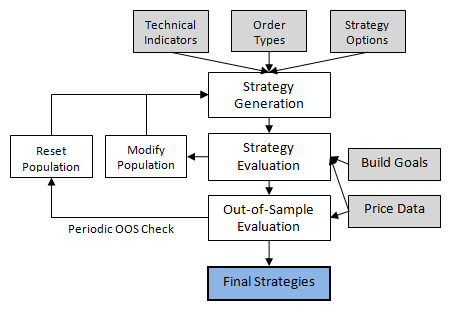
Figure 4. Build algorithm for automatic code generation with
genetic programming.
To generate new members of the population, members of the current population are
selected at random, and the fitter ones are chosen as parents for crossover and
mutation. A less fit member is selected at random to be replaced by the new
member. The process is repeated until as many new members have been created as
there are members in the current population. This step represents one
generation.
Out-of-sample results are computed on a segment of the data not used to
calculate the fitness. An optional check can be made periodically to make sure
the out-of-sample results are positive. If the results are not above a threshold
chosen by the user, the process can be reset, causing the population to be
re-initialized and the generation count to be reset to zero. After the specified
number of generations has been successfully completed, the top strategies are
taken as the ones with the highest fitness.
Entry Conditions
The GP process can be used to evolve two essential strategy elements
simultaneously: entry conditions and orders for entry and exit. The entry
conditions are typically represented as tree structures, as shown below in Fig.
5.
The tree structure enables the generation of entry conditions with considerable
complexity. Each node in the tree has between zero and three inputs, each of
which leads to further branching. The tree is constructed recursively starting
at the top with a logical operator (and, or, >, <, etc.) and proceeding to
technical indicator functions, prices, and, finally, constants, such as
indicator lengths. Each branch is terminated with a node that has no inputs.
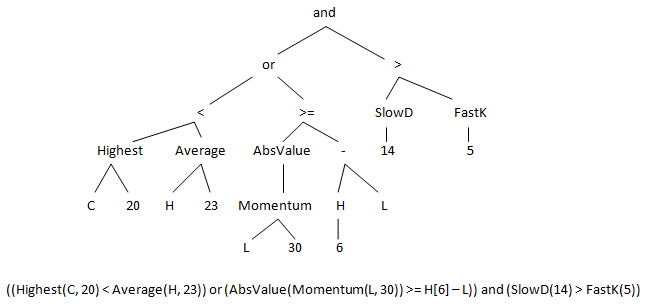
Figure 5. Entry condition example, showing tree structure and
corresponding EasyLanguage code.
The crossover operator of the GP process replaces a subtree in one parent with a
subtree from the other parent. For example, the subtree on the right of Fig. 5,
starting with “>” (i.e., SlowD(14) > FastK(5)), might be replaced with a
different subtree from another member of the population. Mutation changes
individual nodes in the tree. For example, the “Average” node might be replaced
with “Lowest” so that the subtree Average(H, 23) becomes Lowest(H, 23).
An entry condition can be evolved separately for long and short trades or one
entry condition can be logically reversed for the other side of the market. Each
entry condition is a logical statement; it evaluates to either true or false. A
value of true means the entry condition is satisfied for that market side (long
or short), which is necessary for the entry order to be placed.
In order to generate meaningful entry conditions, both syntactic and semantic
rules need to be applied when building the conditions. Syntactic rules ensure
that each node containing a function satisfies the input requirements for the
function. For example, the Momentum function requires a price as the first input
and a length as the second input. Semantic rules ensure that comparisons between
different nodes are meaningful. For example, it makes sense to compare the
Highest(C, 20) to a moving average since both functions return a price. However,
it would not be meaningful to compare the closing price to the time of day or to
compare a stochastic, which has a value between 0 and 100, to a moving average
of price. The semantic rules enforce these requirements.
Order Types
The key to evolving entry and exit orders using genetic programming is
representing the different types of orders in a generalized fashion. For
example, stop and limit entry prices can be represented as follows:
EntryPrice = PriceValue +/- Fr * PriceDiff
where PriceValue is anything that represents a price, such as the O, H, L, C,
Highest(price, N), Average(price, N), and so on; Fr is a constant multiplier;
and PriceDiff is anything that evaluates to the difference between two prices,
such as the average true range (ATR), the difference between two moving
averages, etc.
Using this formula, the following would be valid long stop entry prices:
EntryPrice = Average(C, 10) + 3.5 * AbsValue(C[5] – H[14])
EntryPrice = H + 2 * AbsValue(Average(C, 20) – Lowest(H, 15))
These could also be short limit entries since short limit entries are also above
the market and therefore use a “+” sign to add the price difference to the price
value. Target and protective stop exits can be constructed in much the same way
as stop and limit entry orders.
Applying crossover and mutation to trading orders of this type involves
replacing parts of the orders and/or randomly selecting new parameter values to
create new orders.
Trading Strategy Structure
While genetic programming is capable of generating trading strategies with
considerable variety, it’s necessary to start with a generalized structure for
the strategies to follow. The strategy structure shown below in pseudo-code
provides a framework for building strategies based on entry conditions and order
types like those discussed above:
Inputs: N1,
N2, N3, …
LongEntryCondition = …
ShortEntryCondition = …
If position
is flat and LongEntryCondition is true then
Long
entry order…
Initialize long exit orders as necessary…
If position
is flat and ShortEntryCondition is true then
Short
entry order…
Initialize short exit orders as necessary…
If position
is long then
Long
exit order 1…
Long
exit order 2…
…
If position
is short then
Short
exit order 1…
Short
exit order 2…
…
[Optional end-of-day
exit]
The strategies start with the list of inputs. An input is provided for any
indicator parameter, price pattern look-back length, and any parameters required
by the entry and exit orders, such as the look-back length for the ATR.
The LongEntryCondition and ShortEntryCondition variables are the true/false
entry conditions evolved by the genetic programming process, such as shown in
Fig. 5. A long entry order is placed if the long entry condition is true,
provided the position is currently flat (out of the market). Likewise, a short
entry order is placed if the short entry condition is true, provided the
position is currently flat.
Only one type of entry order is allowed for each side of the market
(long/short), although they can be different for each side. When an entry order
is placed, one or more variables for the exit orders may be initialized within
the entry order code block.
The statements for the exit orders follow the entry orders. One or more exit
orders may be used. It’s helpful to ensure that each strategy has an
exit-at-a-loss and an exit-at-a-profit. This prevents trades from remaining open
indefinitely.
An optional end-of-day exit can be used to ensure intraday strategies exit at
the day’s close.
Example
To illustrate using genetic programming for automatic code generation in
strategy building, the program
Adaptrade Builder
was run on daily bars of a stock index futures market for a small population and
a limited number of generations. The performance metrics chosen to guide the
process were the net profit, number of trades, correlation coefficient,
statistical significance, and the return/drawdown ratio. Specific targets were
set for the number of trades and the return/drawdown ratio. The other selected
metrics were maximized. The fitness function was a weighted average of terms for
each metric.
The population size was set to 100, and all members of the population were
saved. The in-sample/out-of-sample division of data was set to 80% in-sample and
20% out-of-sample (OOS), with the OOS period following the in-sample period. The
build process was run over a total of 10 generations. To illustrate how the
results evolved during the build, the OOS net profit was recorded after the
initial population was generated and after five and 10 generations. Fig. 6
demonstrates that the number of members of the population with OOS net profits
of at least $1,000 increased after five and 10 generations.
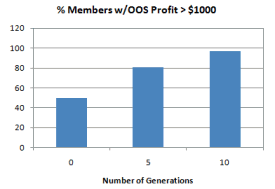
Figure 6.
Percentage of population members with out-of-sample net profit greater than
$1,000.
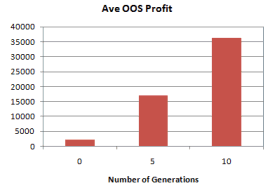
Figure 7. Average out-of-sample net profit of population
members.
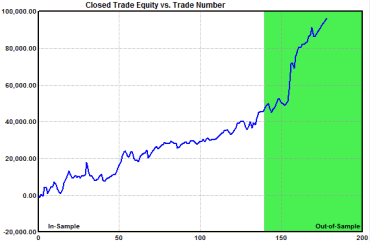
Figure 8. Closed trade equity curve after 10 generations.
Similarly, the average OOS net profit of the population increased after five and
10 generations, as shown in Fig. 7. Note that these results are for the OOS net
profit. By definition, the out-of-sample data is not used in the build, so OOS
results are unbiased; they don’t benefit from hindsight. This implies that the
GP process not only tends to improve the in-sample results over successive
generations, which is a direct effect of the GP algorithm, but the OOS results
also tend to improve as the strategies are evolved. This indicates a high
quality build.
The equity curve for one of the top strategies is shown above in Fig. 8 after 10
generations, with the out-of-sample equity curve shown in green.
Finally, the EasyLanguage (TradeStation) code for the corresponding strategy is
listed below.
{
EasyLanguage
Strategy Code
for TradeStation
Population
member: 46
Created by:
Adaptrade Builder version 1.1.0.0
Created:
10/19/2010 2:19:52 PM
TradeStation
code for TS 6 or newer
Price File:
C:\TestData.txt
Build Dates:
}
{ Strategy
inputs }
Inputs: NL1
(74),
NL2
(20),
NL3
(85),
NBarEnL1 (59),
NATREnL (84),
EntFrL
(3.8189),
NATRTargL (57),
TargFrL (1.6168),
NBarExL (100),
NBarEnS1 (40),
NBarEnS2 (49),
NBarEnS3 (7),
EntFrS
(0.6971),
NBarExS
(6),
NATRTrailS (33),
ATRFrTrailS (1.4126),
TrailPctS (50.0000);
{ Variables
for average true range for entry and exit orders }
Var: ATREnL
(0),
ATRTargL (0),
ATRTrailS (0);
{ Variables
for money management and/or trailing stop exit orders }
Var: SStop
(0),
NewSStop (0),
STrailOn (false);
{ Variables
for entry conditions }
Var:
EntCondL (false),
EntCondS (false);
{ Average true
range }
ATREnL =
AvgTrueRange(NATREnL);
ATRTargL =
AvgTrueRange(NATRTargL);
ATRTrailS =
AvgTrueRange(NATRTrailS);
{ Entry
conditions }
EntCondL = (Highest(Volume,
NL1) >= Lowest(Volume, NL2)) or (Volume < Average(Volume, NL3));
EntCondS =
true;
{ Entry orders
}
If
MarketPosition = 0 and EntCondL then begin
Buy next
bar at XAverage(L, NBarEnL1) + EntFrL * ATREnL stop;
end;
If
MarketPosition = 0 and EntCondS then begin
Sell short
next bar at Highest(H, NBarEnS1) - EntFrS * AbsValue(Lowest(L, NBarEnS2) -
Lowest(H, NBarEnS3)) stop;
STrailOn =
false;
SStop =
Power(10, 10);
end;
{ Exit orders,
long trades }
If
MarketPosition > 0 then begin
If
BarsSinceEntry >= NBarExL then
Sell
next bar at market;
Sell next
bar at EntryPrice + TargFrL * ATRTargL limit;
end;
{ Exit orders,
short trades }
If
MarketPosition < 0 then begin
If
EntryPrice - C > ATRFrTrailS * ATRTrailS then
STrailOn
= true;
If STrailOn
then begin
NewSStop
= EntryPrice - TrailPctS * (EntryPrice - C)/100.;
SStop =
MinList(SStop, NewSStop);
end;
If
BarsSinceEntry >= NBarExS then
Buy to
cover next bar at market;
If STrailOn
then
Buy to
cover next bar at SStop stop;
end;
Until recently, most applications of genetic programming to trading strategy
generation have been academic studies based on limited rule sets, overly simple
entry and exit logic, and custom-written code, making the results unsuitable for
most traders. At the same time, most available software that implements GP for
market trading has either been targeted to professional traders and priced
accordingly or is very complicated to set up and use. Adaptrade Builder was
designed to make GP simple to use for any trader, individual or professional,
who has a basic understanding of strategy trading and the TradeStation platform.
More information on Builder can be found at
www.Adaptrade.com/Builder/.
Over-fitting
Building trading systems via automatic code generation is a type of
optimization. Most systematic traders are probably familiar with parameter
optimization, in which the inputs to a strategy are optimized. Unlike parameter
optimization, automatic code generation optimizes the strategy’s trading logic.
Nonetheless, the risk of over-optimization, or “over-fitting”, is also a concern
for automatic code generation, just as it is for parameter optimization.
Typically, optimization is performed over one segment of data, called the
optimization or in-sample segment, and tested on different data, called the test
or out-of-sample segment. Over-fitting refers to the problem of optimizing a
strategy so that it fits the in-sample segment well but doesn’t work well on any
other data, including the out-of-sample data.
Poor out-of-sample performance is usually caused by one of several factors. One
important factor is the so-called number of degrees-of-freedom in the in-sample
segment. The number of degrees-of-freedom, which is equal to the number of
trades minus the number of rules and conditions of the strategy, determines how
tightly the strategy fits the data. Provided inputs are added for each parameter
in the strategy, the number of strategy inputs can be used as a proxy for the
number of rules and conditions. For example, if a strategy has 100 trades and 10
inputs, it has 90 degrees-of-freedom. The more degrees-of-freedom, the less
likely it is that the strategy will be over-fit to the market and the more
likely it is that it will have good out-of-sample performance.
The number of degrees-of-freedom can be increased during the build process by
including the number of trades and/or the number of strategy inputs as build
goals. Assuming the fitness metric is a weighted average of the build goals, all
other things being equal, increasing the weighting for the number of trades will
result in strategies with more trades and therefore more degrees-of-freedom.
Likewise, increasing the weighting for the (negative) number of inputs will
result in strategies with fewer inputs, which will also increase the number of
degrees-of-freedom.
Another option is to include the statistical significance as a build goal. The
statistical significance can be calculated by applying the Student’s t test to
the average trade. This will measure the probability that the average trade is
greater than zero. The t test is based on the number of degrees-of-freedom but
is a more complete measure of whether a strategy is over-fit than the number of
degrees-of-freedom alone. One way, then, to improve out-of-sample performance is
to include the significance in the fitness function, which will tend to generate
strategies that have a high statistical significance.
Another important factor affecting out-of-sample performance is the variety of
market conditions in the in-sample segment. Generally speaking, it’s better to
optimize over data that includes a wide variety of market conditions, such as up
trending and down trending markets, periods of consolidation, high and low
volatility, etc. The more variety in the in-sample segment, the more likely it
is that the strategy will perform well on other data, including out-of-sample
data and in real-time trading. While the future never exactly duplicates the
past, provided the future (or out-of-sample data) is similar enough to at least
part of the in-sample segment, the strategy should perform well on new data.
The value of optimizing over a variety of market conditions presumes that good
performance is achieved over each part of the in-sample segment. One way to
measure this is with the correlation coefficient of the equity curve, which
measures how closely the equity curve approximates a straight line. If the
equity curve is a straight line, it implies that the performance is uniform over
all segments of the data. Obviously, this is desirable if the goal is to achieve
good performance over as many different types of market conditions as possible.
The correlation coefficient for the strategies generated via automatic code
generation can be increased by including the correlation coefficient as a build
goal and weighting it as part of the fitness function.
Unfortunately, there will be cases where even with a high significance, a
correlation coefficient close to 1, and a wide variety of market conditions in
the in-sample segment, the out-of-sample performance will be poor. This can
happen for several reasons. First, even a simple strategy with few parameters
can in some cases fit the noise rather than the signal. By definition, noise is
any part of the market data that does not contribute to profitable trading
signals. Secondly, the market dynamics on which the strategy logic is based
(i.e., the signal) may have changed in the out-of-sample segment enough to
negatively impact performance. This is sometimes due to a fundamental change in
the market, such as the switch from floor-based to electronic trading. However,
more subtle changes, often related to the trading patterns of market
participants, are also possible, particularly for shorter-term trading.
If this appears to be the problem, the solution may be as simple as rebuilding
the strategy with new trading logic. Using a tool such as
Adaptrade Builder
makes this much easier than if a manual approach to trading strategy development
were used. Another possible solution is to include the most recent data in the
optimization segment and test it out-of-sample by tracking the performance in
real-time. In most cases, a strategy that has a large number of trades, a high
significance value and good performance on the in-sample segment will continue
to perform well for some period of time post-optimization.
For information on software for
building trading strategies using genetic programming,
please click here.  |
If you'd like to be informed of new
developments, news, and special offers from Adaptrade
Software, please join our email list. Thank you.
|